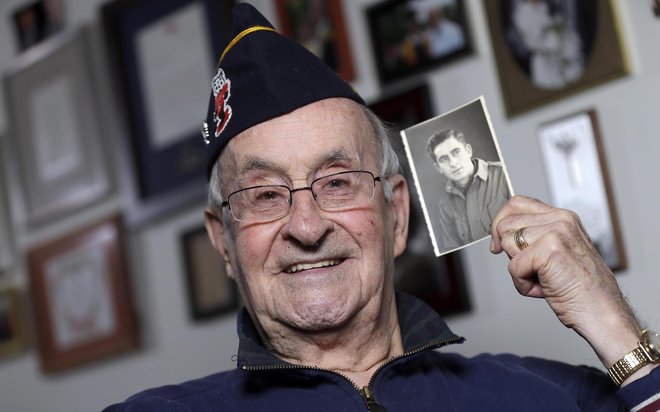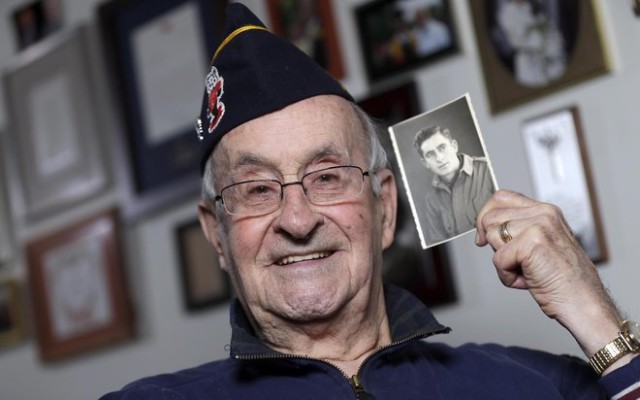Ralph Ticcioni’s first taste of France and all things French was of a barn roof – his parachute had caught on the weather vane! It was D-Day, and Ticcioni arrived in France with thousands of other American soldiers, parachute and airmen.
It was June 6, 1944, and Ticcioni sat in the back of a transport plane, weighed down with 80 pounds of gear, his face darkened with charcoal. The light on the wall turned yellow, and he stood up with the rest of his 82nd Airborne unit and clipped his static line hook to an overhead wire. He checked the soldier in front of him, while the soldier behind Ticcioni checked to ensure his static line hook was secure. This wouldn’t be his first jump, but it was his first into combat.
The light turned green. He jumped.
“Of all places, I landed on top of a barn,” Ticcioni, now 93, recalls. “The barns in this area of Normandy were thatch, so it was a soft landing. I hung there for a while and got my thoughts together, got out my knife, and cut myself down. I slid down into some horse manure.”
From the barn, Ticcioni and his comrades would fight their way across Europe, helping to liberate a continent devastated by war. When the war ended, he returned home to Milwaukee and got a job at a dairy, eventually working his way up to plant manager and retiring after 40 years. After his first wife died, he remarried. His second wife died six years ago. Now it’s just Ticcioni, his stepson, and stepdaughter.
He never returned to France, but that might change. This June, Ticcioni has been invited to return to take part in the D-Day anniversary commemoration in the French village of Sainte-Mère-Église, which is the first community in Normandy to be liberated on D-Day.
Ticcioni’s thrilled for the chance to return. He hopes to see the large church in Sainte-Mère-Église, featuring stained-glass windows of paratroopers. There is even a mannequin who hangs from the roof, re-creating the paratrooper who landed on the roof and dangled from his harness. There is a museum dedicated to the American Airborne troops that he wants to visit in the village.
“They say they’re still very appreciative for what the Allies did. I don’t feel I should be treated royally,” said Ticcioni, who lost close friends in the war. “I believed then and I believe now the real heroes are buried over there.”
In a way, the modest veteran, who lives in a neatly-tended apartment with family pictures on his wall at a New Berlin senior living center, will represent the American soldiers who did not get to come home. With the upcoming trip, Ticcioni went to the post office to apply for a passport, which was something he didn’t need when he parachuted into France in 1944.
In January, Ticcioni received a thank-you letter, delivered by Karyn Roelke from Stars and Stripes Honor Flight. The letter was from schoolchildren in Normandy. The children in Normandy have participated in a peace project in which they send thank-you notes in decorate envelopes to veterans. These letters were sent to veterans’ organizations in the United States and sent to veterans such as Ticcioni.
Roelke took photos of the southeastern Wisconsin veterans holding their thank-you notes, and sent them to Michelle Coupey. Coupey is part of the Friends of American Veterans group (or Amis des Vétérans Américains, in French) located in Sainte-Mère-Église. When Coupey learned that Ticcioni served in the 82nd Airborne, was healthy, and had never returned to France, the Friends of American Veterans group offered to pay to bring Ticcioni and a companion back to France.
Coupey herself is an American. She married a Frenchman and lives with her family near Sainte-Mère-Église. “The French are so grateful to the Allied soldiers who liberated them,” she said.
The celebration will be a week-long affair, with banquets, memorial services, and ceremonies – all of which will host Ticcioni as guest of honor. A parachute jump is planned, with hundreds of military paratroopers from the U.S. and European countries as well as World War II re-enactors. A local family will host Ticcioni, and he can attend all, or as many of the events he wants to, according to Coupey. If he’s feeling particularly adventurous, he could try to find the spot where he landed his parachute, with help of course.
The years following the end of World War II saw many American veterans returning to Normandy for D-Day observances. In the recent years, however, those numbers have dwindled sharply. The 70th anniversary saw a huge turnout in 2014, but very few attended in 2015, Coupey said.
“When veterans come back, they’re like rock stars. They’re bigger than rock stars. Everyone wants to shake their hand, take their picture with them,” Coupey said.
Ticcioni’s traveling companion will be his physician, Edward Smith. Smith is a veteran himself – of the first Gulf War. He helped Ticcioni fill out an application for a Stars and Strips Honor Flight in 2012, and also served as his guardian on that flight.
“He doesn’t dwell on the risks that he took and all the courage that it took to jump out of that plane hatch. He also feels strongly the loss of his buddies who are still over there,” Smith said. “The people buried in the cemeteries can’t speak and the people in Normandy can’t thank them face to face. When he goes over there he’ll be representing all those boys who couldn’t come back.”

